Japanese Snapping Shrimp
Alpheus bisincisus
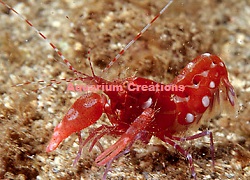
Description:
The Japanese Snapping Shrimp also be called the Red Snapping Shrimp, is found from the West Pacific Ocean to the Red Sea to Japan. Their body is a deep red with white spots. The base of the tail and the claws banded in white. The Japanese Snapping Shrimp inhabits rubble bottom areas where it builds a burrow in the sand and often forms a symbiotic relationship with several different goby species for protection from predators. The reason they need the protection is their very poor vision. Best environment is a sand substrate, live rock with hiding places, and areas of low light such as caves and overhanging shelves. If in pairs, one will often stand guard at the burrow while the other is inside. Besides the fun of having them in your aquarium they are a worker, moving the sand substrate around, stirring up all the caught up detritus. Their work continues as they scavenge all the uneaten food they find.
Food and diet:
Feeding this shrimp should not be a problem since they should scavenge the tank for any uneaten foods and detritus. They will accept any meaty freeze dried or frozen foods and bottom feeder tablets, as well as scavenge for algae in the aquarium. Snapping Shrimp are intolerant of copper medications and aquarium high nitrate levels.
Level of Care: Easy
Reef Compatibility
:Excellent
Approximate Purchase Size:
3/4" to 1-1/2"
|
Price Each $34.99 ea.
|
Candy Stripe Randalls Pistol Shrimp
Alpheus bellulus
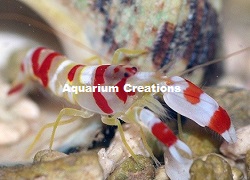
Description:
The attractive Candy Stripe Randalls Pistol Shrimp is colored with alternating red and white bands. By far the interesting aspect of pistol shrimp are their ability to form a symbiotic relationship with some species of goby fish. This is commonly seen in pistol shrimps belonging to the genus Alpheus such as the tiger pistol shrimp and Randall's pistol shrimp. These beneficial shrimp will constantly move gravel making them excellent sand stirrers in the reef aquarium, as well as scavenging any uneaten food. The sound it makes comes from an appendage on the pincher which moves when the pincher is opened or closed and water is ejected. The Tiger Pistol Shrimp have a symbiotic relationship with gobies . The goby, with better eyesight, warns the shrimp of predators. The shrimp share its food with the goby. Tiger Pistol Shrimp thrive in environments with sand, rock caves, and areas of lower light. They will hang out in the lower portion of the tank, near rocks or ledges to keep out of the direct light. If in pairs, one will often stand guard at the burrow while the other is inside.
Food and diet:
Feeding this shrimp should not be a problem since they should scavenge the tank for any uneaten foods and detritus. They will accept any meaty freeze dried or frozen foods and bottom feeder tablets, as well as scavenge for algae in the aquarium. Snapping Shrimp are intolerant of copper medications and aquarium high nitrate levels.
Level of Care: Easy
Reef Compatibility
:Excellent
Approximate Purchase Size:
1/2" to 1-1/4"
|
Price Each $34.99 ea.
|
Tiger Snapping Shrimp
Alpheus bellulus
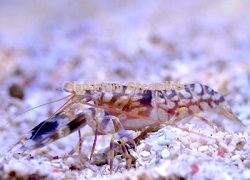
Description:
The Tiger Snapping shrimp also called the Tiger Pistol Shrimp has a most interesting ability to form a symbiotic relationship with many species of goby fish. This is commonly seen in pistol shrimps belonging to the genus Alpheus such as the tiger shrimp and Randall's shrimp. The Tiger Snapping Shrimp's body is tan with rust coloured broken stripes running across the back and vivid Blue stripes on its legs, arms, and antennae. These beneficial shrimp will constantly move gravel making them excellent sand stirrers in the reef aquarium, as well as scavenging any uneaten food. The sound it makes comes from an appendage on the pincher which moves when the pincher is opened or closed and water is ejected. The Tiger Pistol Shrimp have a symbiotic relationship with gobies . The goby, with better eyesight, warns the shrimp of predators. The shrimp share its food with the goby. Tiger Pistol Shrimp thrive in environments with sand, rock caves, and areas of lower light. They will hang out in the lower portion of the tank, near rocks or ledges to keep out of the direct light. If in pairs, one will often stand guard at the burrow while the other is inside.
Food and diet:
Feeding this shrimp should not be a problem since they should scavenge the tank for any uneaten foods and detritus. They will accept any meaty freeze dried or frozen foods and bottom feeder tablets, as well as scavenge for algae in the aquarium. Snapping Shrimp are intolerant of copper medications and aquarium high nitrate levels.
Level of Care: Easy
Reef Compatibility
:Excellent
Approximate Purchase Size:
1" to 1-3/4"
|
Price Each $24.99 ea.
|
Coral Banded Shrimp
Stenopus hispidus
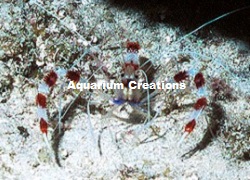
Description:
Coral Banded Shrimp are very popular among reefkeepers due to their exquisite coloring and active nature. They are a beautiful addition to the reef with candycane striped bodies, multiple pairs of bright white antennae, and 3 pairs of miniature claws. They are very active and enjoy lots of live rock to scour for detritus, and will hunt and kill pest bristle worms. They are also active "cleaner shrimp". Fish will swim close and allow the shrimp to pick parasites from the flesh. They will also feed on uneaten fish food that falls to the bottom such as frozen foods, pellet and flake. They are reef-safe and only one should be kept per tank, unless they are a confirmed mated pair in which case the pair can be kept in the same tank. Hardy, but must be acclimated slowly to avoid any salinity and/or pH shock.
Food and diet:
Coral Banded Shrimp shrimp are omnivores that will eat anything meaty and some greens. They will graze from one end to another end of the tank on microalgae's. But upon introducing a few pellets or a tasty morsel of some sort they head straight for it. Generally any kind of sinking pellet will do.
Level of Care: Easy
Reef Compatibility
:Excellent
Approximate Purchase Size:
1-1/2" to 2"
|
Coral Banded Shrimp qty 1 $14.99 ea.
Mated Pair of Coral Banded Shrimp $44.99
|
Golden Coral Banded Shrimp
Stenopus zanzibaricus
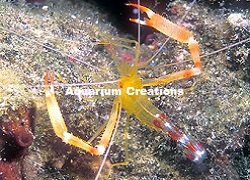
Description:
The Golden Coral Banded Shrimp is closely related to the Coral Banded Shrimp. These shrimp have bright golden yellow bodies complimented by red and orange striping.They are a beautiful addition to the reef with candycane striped bodies, multiple pairs of bright white antennae, and 3 pairs of miniature claws. They are very active and enjoy lots of live rock to scour for detritus, and will hunt and kill pest bristle worms. They are also active "cleaner shrimp". Fish will swim close and allow the shrimp to pick parasites from the flesh. They will also feed on uneaten fish food that falls to the bottom such as frozen foods, pellet and flake. They are reef-safe and only one should be kept per tank, unless they are a confirmed mated pair in which case the pair can be kept in the same tank. Hardy, but must be acclimated slowly to avoid any salinity and/or pH shock.
Food and diet:
Coral Banded Shrimp shrimp are omnivores that will eat anything meaty and some greens. They will graze from one end to another end of the tank on microalgae's. But upon introducing a few pellets or a tasty morsel of some sort they head straight for it. Generally any kind of sinking pellet will do.
Level of Care: Easy
Reef Compatibility
:Excellent
Approximate Purchase Size:
Small 3/4" to 1-1/4" Medium 1 1/4" to 1 3/4" Large 1 3/4" to 2 1/2"
|
Small $27.95
Medium $32.95
Large $39.95
|
Blue Body Coral Banded Shrimp
Stenopus tenuirostris
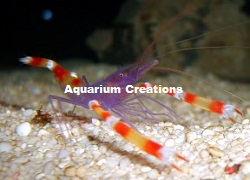
Description:
The Blue Coral Banded Shrimp differs in having blue on the abdomen and legs, and it's also much less frequently available than the regularly seen coral banded shrimp. These popular shrimps are easy to keep and are great in reef tanks. They require no special care once acclimated, and the will eat about anything offered. They may also eat bristleworms. (hurray!) Like all shrimps, they require careful acclimation.Hardy, but must be acclimated slowly to avoid any salinity and/or pH shock. These animals are known to loose their claws or legs during normal shipping practices. They will grow back after the next molt.
Food and diet:
The Blue Coral Banded Shrimp shrimp are omnivores that will eat anything meaty and some greens. They will graze from one end to another end of the tank on microalgae's. But upon introducing a few pellets or a tasty morsel of some sort they head straight for it. Generally any kind of sinking pellet will do.
Level of Care: Easy
Reef Compatibility
:Excellent
Approximate Purchase Size:
1" to 1-1/4"
|
Price Each $33.99 ea.
|






